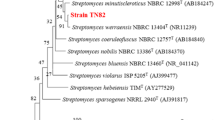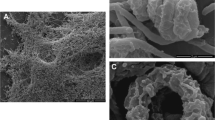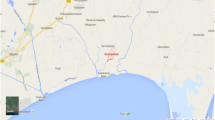Abstract
In the present study a cytotoxic secondary metabolite, 4-hydroxy-4-(4-nitrophenyl)butan-2-one (compound-1), was isolated from the fermentation broth of the terrestrial actinomycetes. The strain was collected from high altitude regions of Kashmir and it was confirmed as Streptomyces collinus (SRP-19) on the basis of 16S rDNA analysis. To the best of our knowledge the compound-1 has not been reported so far from natural sources. The structure of the isolated compound was established by means of spectroscopic analysis including 1H, 13C, 2D NMR and it was also evaluated for its cytotoxic potential against four cancer cell lines, viz., HeLa, PC-3, THP and Caco-2 cells. Compound 1 exhibited significant cytotoxic activity, having IC50 values within a range of 5.39–8.86 μM.
Similar content being viewed by others
Avoid common mistakes on your manuscript.
Introduction
Natural products have been proved as a rich source for therapeutic discovery, as per recent review 74.8 % of small molecules used for cancer are non-synthetic (Newman and Cragg, 2012). The importance of natural products increased enormously due to high failure rate of other alternative drug discovery methods (Butler, 2004). Actinomycetes, is a group of microbes which have played a important role in antibiotic discovery (1940–1960) and still affording clinically useful bioactive principles (Takahashi and Omura, 2003; Walsh, 2003; Baltz, 2008). Till date, there are only few reports on diversity and activity of actinomycetes from various terrestrial extreme ecosystems, like desert, hills and forests (especially in higher altitudes) (Balagurunathan and Radhakrishnan, 2007). The compounds isolated from soil actinomycetes, posses broad spectrum of biological activities such as antibacterial, antifungal, antiviral, neurotoxic and antineoplastic activities (Black et al., 1982). Streptomyces, a most explored genus of actinomycetes, have led as producers of useful bioactive compounds (Tanaka and Omura, 1990) and more than half of the naturally occurring antibiotics discovered till date, have been reported from the genus ‘Streptomyces’ alone (Miyadoh, 1993). The present study reports isolation of a potent cytotoxic metabolite from terrestrial actinomycetes, which was collected from Thajwas glacier (high altitude region of Kashmir) and it was characterized as Streptomyces collinus on the basis of 16S rDNA analysis. The activity of crude extracts of this strain, inspire us to isolate a pure cytotoxic compound from ethyl acetate fraction of the extract.
Materials and methods
Microorganism collection
The microorganism was isolated from the soil sample collected from Thajwas Apparwath Lake, Sonamarg region of Kashmir, India. An aliquot of soil (1 g) was suspended in 9 ml sterile water and mixed by shaking vigorously for 30 min. The supernatant was diluted serially (10−1, 10−2, 10−3 10−4, 10−5) with sterile water, 100 μl of each dilution was spread onto starch-casein agar medium (Kuster and Williams, 1964) and International Streptomyces Project (ISP-1) medium recommended by Shirling and Gottlieb (Moncheva et al., 2000–2002), which were supplemented with nalidixic acid (1 mg) and cycloheximide (10 mg). The plates were incubated for 10–14 days at 28 °C. The resulting colonies were purified and maintained on ISP-1 agar slants. Amongst the all isolated actinomycete strains, one strain that showed significant cytotoxic activity was designated as Streptomyces collinus (SRP-19).
Strain identification
For identification to the genus level, the selected isolate was grown in ISP-1 media for 72 h at 28 °C. The cell mass was separated by centrifugation and genomic DNA was prepared using modified CTAB method (Doyle and Doyle, 1987). The 16S rRNA gene was selectively amplified by PCR using universal primers, 27F—(5-AGAGTTTGATCMTGGCTCAG-3) and 1525R—(5-AAGGAGGTGWTCCARCC-3). The PCR amplification was carried out in 0.2 ml PCR tubes, using Master cycler personal (Eppendroff). The PCR reaction mixture (50 μl) contained 25 μl of PCR master mix (Genei, Bangalore, India), 1 pmoll − 1 of each primer, and 100 ng of template DNA. Thermal cycling conditions were as follows: initial denaturation (3 min at 95 °C), followed by 30 cycles of denaturation (94 °C for 15 s), annealing (55 °C for 30 s), and primer extension (72 °C for 45 s), followed by final extension step for 7 min at 72 °C. The purified amplified product was sequenced by ABI genetic analyser 3130XL.
Phylogenetic analysis
The 16 S rDNA gene sequence was aligned to sequences retrieved from NCBI databases, using multiple sequence alignment software (CLUSTAL W). Phylogenetic analysis was carried out using MEGA software ver. 4.0 (Tamura et al., 2007). The neighbour-joining (NJ) method was used to infer the evolutionary history of the isolates and the bootstrapping was carried out using 1,000 replications. Streptomyces collinus was taken as out group (Fig. 1 ). The sequence was deposited with NCBI GenBank (Accession No KC355417).
Fermentation study
The well-developed colonies of the selected isolate of Streptomyces collinus (SRP-19) were inoculated into a 250 ml flask containing 100 ml of ISP-2 media. The pH of the medium was adjusted at 7.2 using 1 N NaOH solution before sterilization. After incubation at 28 °C for 4 days in an incubator with shaking at 180 rpm, this preculture was used to inoculate (5 % v/v) a total volume of 4 L culture medium having the same composition as the preculture (250 ml in 1,000 ml Erlenmeyer flasks). The flasks were incubated under similar conditions for 10 days.
Extraction and isolation
The fermentation broth was harvested after 10 days and centrifuged at 6,000 rpm for 10 min. The cell free supernatant was extracted three times with ethylacetate and concentrated under reduced pressure. The crude extract (740 mg) obtained was passed through a Sephadex (LH-20) column using methanol as an eluting agent at a flow rate 1.5 ml min−1 to give enriched fraction (15–22) and which after further purification by preparative TLC (CHCl3 in MeOH 90:10) afforded 16.5 mg (yield 2.2 % of crude extract) of compound 1 (Fig. 2). Purity of the compound was 93.84 %.
Chemical analysis
1H and 13C NMR spectra were recorded on a Bruker-Avance 400 MHz FT-NMR spectrometer operating at 400 and 100 MHz, respectively. The chemical shifts were expressed as 1 (ppm, parts per million) referring to internal standard, tetramethylsilane (Me4Si). HRMS data were acquired using electrospray ionization on an Agilent 6540 (Q-TOF) high resolution mass spectrometer. The IR spectra were recorded on a Perkin-Elmer Spectrum BX FT-IR spectrometer. Sample pellets were prepared in KBr using hydraulic pellet press of Kimaya manufacturers. The purity of isolated compound 1 was analysed by high performance chromatography (HPLC) conducted on Agilant 2600 series comprising photdiode-array (PDA) detectors, and auto injector with 100 μL sample loop, using RP-18 column (E-Merck, 5 μm, 250 mm, 4.0 mm) at 254 nm. The mobile phase consisted acetonitrile–water (60:40) at column temperature 30 °C and flow rate was 0.7 ml min−1.
Cytotoxic activity
All cell lines (HeLa, PC-3, THP-1 and Caco-2) were purchased from European Collection of Cell Culture (ECACC), Fetal Bovine Serum (FBS), RPMI-1640, Minimum Essential Medium (MEM), Penicillin G, Streptomycin and Trypsin–EDTA were obtained from Invitrogen Corp. 5-diphenyltetrazolium bromide (MTT) was obtained from Sigma Chemicals Co. (St. Louis, MO). Cells were cultured in RPMI 1640/MEM containing 10 % fetal bovine serum in the presence of 70 mg l−1 penicillin and 0.1 g l−1 streptomycin and were incubated at 37 °C with 95 % air and 5.0 % carbon dioxide. All cells were used in experiments during the linear phase of growth. All the assays were carried out using staurosporine as standard and dimethyl sulfoxide (DMSO) as vehicle.
Cell proliferation assay
The cell viability was determined by standard MTT dye uptake method (Koppikar et al., 2010). In brief, HeLa, PC-3, THP and Caco-2 cells (3 × 103) cells/well were plated into a 96-well tissue culture plate and treated with different concentration of the compound 1 in triplicate so that the final concentration of DMSO solvent was 0.2 %. After 48 h incubation, MTT solution was added and cells were cultured for another 4 h at 37 °C in 5.0 % CO2 incubator. The amount of coloured formazan derivative was determined by measuring optical density (OD) using TECAN microplate reader (Infinite M200 PRO) at 570 nm. The percentage viability was determined according to the protocol described, and the IC50 was calculated by software graph pad prism (Garg et al., 2008).
Clonogenic assay
In this assay the HeLa cells were plated at a seeding density of (1 × 103 cells/well) in 6-well tissue culture grade plates. After 24 h the culture medium was changed and new medium was added and cells were exposed to various concentrations of compound 1 along with vehicle (DMSO) for 5 days at 37 °C incubator in 5 % CO2. Later on, the obtained colonies were fixed with 4 % paraformaldehyde and were stained with 0.5 % crystal violet solution. The colonies from the plates were counted and averaged from the observed fields randomly (n = 3) and photographed with Olympus c-7070 wide 700 M inverted microscope camera (Lotan et al., 1985).
Scratch motility (wound healing) assay
The assay performed was same as described above, except HeLa cells were seeded in a 6-well plate at a concentration of (5.5 × 105 cells/well) and allowed to form a confluent monolayer for 24 h, it was then serum starved for 24 h. After that the monolayer was scratched with a sterile pipette tip (200 μl), washed with serum free medium to remove floated and detached cells and photographed (time 0 h). Cells were successively treated in medium containing low serum (1.0 %) in the presence of different concentrations of compound 1 (2.5, 5.0, and 7.5 μM) along with vehicle (DMSO) for 24 h. Wounded areas were progressively photographed with Olympus c-7070 with 700 M camera (100× magnification). The percentage of wound closure was estimated by the following equation: wound closure % = [1−(wound area at t 1/wound area at t 0) × 100 %], where t 1 is the time after wounding and t 0 is the time immediately after wounding (Agarwal et al., 2005; Holeiter et al., 2008).
Results and discussion
In the present study a bioactive molecule, 4-hydroxy-4-(4-nitrophenyl)butan-2-one (compound 1), was isolated from ethylacetate extract of Streptomyces collinus. The Streptomyces strain was identified by 16S rDNA gene sequence alignment with the sequences retrieved from NCBI public databases (http://www.ncbi.nem.nih.gov), analysis indicated that the strain belongs to the genus Streptomyces.
Structure determination of compound 1
Compound 1 obtained as a colourless gum was assigned the molecular formula C10H11NO4 on the basis of HRESIMS, which showed a quasi-molecular ion at m/z 208.06227 [M−H]− (calcd. m/z 209.06881). The IR spectrum of compound 1 showed the presence of hydroxyl (3,338 cm−1), carbonyl (1,725, 1,622 cm−1), phenyl (1,622, 1,578, 1,474 cm−1) and aromatic nitro groups (1,520, 1,330 cm−1), respectively. 13C NMR spectrum of compound 1 showed 10 carbon resonances, which were further classified by DEPT and HSQC experiments into the categories of 1 methyl, 1 methylene, 5 methines (including 4 aromatic carbons) and 3 quaternary carbons (including 2 phenyl and 1 carbonyl carbon). The 1H-NMR spectrum exhibited a set of signals characteristic of a 1,4-disubstituted phenyl moiety. Characteristic 13C resonances including those of one downfield sp2 carbon at δ 153.2 (C-1) and one quaternary carbon at δ 148.6 (C-4) together with two aromatic CH doublets at δ 8.12 (2H, d, J = 7.2) and 7.52 (2H, d, J = 7.2) indicated the presence of a 1,4-disubstituted benzene ring. One methylene at δ 53.3 (C- 7), one methine at δ 70.1 (C-8), one terminal methyl group at δ 30.8 (C-10) and one carbonyl carbon at 209.2 (C-9) seen in compound 1, conjunction with the 1H-1H COSY interactions of aliphatic protons, suggested the existence of a–CHOH–CH2–CO–CH3 segment in compound 1. The HMBC correlation from methyl group (δ 2.09, 3H,H-10, s) to carbonyl carbon δ 209.2 (C-9), methylene carbon δ 53.3 (C-8) along with correlation from methylene group (2.78, 2H, H-8, m, J = 1.6, 4.4, 12.0 Hz) to carbonyl carbon δ 209.2 (C-9), methyne carbon δ 70.13 (C-7) and quaternary carbon at δ 148.6 (C-4) of benzene ring further confirmed the presence of –CHOH–CH2–CO–CH3 at C-4 of benzene ring. Partial structure obtained so far was further refined with the help of HMBC and COSY. The absolute stereochemistry at C-7 was found to be R as determined by Chiral HPLC separation using a previously reported method (Guo et al., 2005). Thus, the structure of compound 1 (Fig. 3) was determined to be 4-hydroxy-4-(4-nitrophenyl)butan-2-one. Finally, the structures of compounds 1 were confirmed by comparing its NMR data with literature data (Guo et al., 2005).
1H NMR (400 MHz, MeOD, δ, TMS = 0) 8.12 (2H, d, J = 8.8, 1.6 Hz, H-3,5), 7.52 (2H, d, J = 8.8, 1.6 Hz, H-2,6), 5.14 (1H, t, J = 4.4 Hz, H-7), 2.78 (2H, m, J = 1.6, 4.4, 12.0 Hz,CH2), 2.09 (3H, s, -CH3) 13C-NMR (100 MHz, MeOD, δ, TMS = 0) 209.24 (C-9), 153.24 (C-1), 148.62 (C-4), 128.01 (2C symmetric, C-2 and C-6), 124.78 (2C symmetric, C-3 and C-5), 70.13 (C-7), 53.33 (C-8), 31.33 (C-10). Mass, 208.06227 [M−H], 190.05174 [M−H2O].
Compound 1 inhibits cell motility and colony formation of HeLa cells
To evaluate the antimetastatic activity of compound 1, we assessed the effect of compound 1 on the migration by the wound healing assay. As shown in (Fig. 4a, b), the cellular motility was obviously inhibited in a dose-dependent manner by compound 1 on the invasive potential of HeLa cells in in vitro. Wound healing assays were used to determine whether sub-toxic concentration of compound 1 could inhibit motility of Hela cells. After 48 h, cell monolayer’s were wounded, the vehicle (DMSO) treated cells had completely filled in the cleared area, whereas treatment with 2.5 and 5.0 μM of compound 1 significantly (p < 0.05) abrogates motility and invasion potential of HeLa cells.
One of the hallmark traits of cancer cells is their ability to undergo isolated colonial growth. The cytotoxic activity of compound 1 was further shown using a Colony formation assay on HeLa cells. Compound 1 causes significant (p < 0.05), dose-dependent inhibition of colony formation of cells (Fig. 4c, d). Thus compound 1 has distinct cytotoxic cell killing activity in HeLa cells.
The compound 1 significantly exhibited cytotoxic effect in a panel of cell lines tested, having IC50 within a range of 5.39–8.86 μM (Fig. 5). Collectively, these results (Table 1) demonstrate that compound 1 is a prospective cytotoxic compound derived from microbial source.
References
Agarwal R, D’Souza T, Morin PJ (2005) Claudin-3 and claudin-4 expression in ovarian epithelial cells enhances invasion and is associated with increased matrix metalloproteinase-2 activity. Cancer Res 65:7378–7385
Balagurunathan R, Radhakrishnan M (2007) Actinomycetes: diversity and their importance. In: Trivedi PC (ed) Applied microbiology: applications and current trends. Pointer, New Delhi, pp 297–329
Baltz RH (2008) Renaissance in antibacterial discovery from actinomycetes. Curr Opin Pharmacol 8:557–563
Black RE, Brown KD, Becker S, Yunus M (1982) Longitudinal studies of infectious diseases and physical growth of children in rural Bangladesh. Am J Epidemiol 115:305–314
Butler MS (2004) The role of natural product chemistry in drug discovery. J Nat Prod 67(12):2141–2153
Doyle JJ, Doyle JL (1987) A rapid DNA isolation procedure for small quantities of fresh leaf tissue. Phytochem Bull 19:11–15
Garg M, Kanojia D, Khosla A, Dudha N, Sati S, Chaurasiya D, Jagadish N, Seth A, Kumar R, Gupta S, Gupta A, Lohiya NK, Suri A (2008) Sperm-associated antigen 9 is associated with tumor growth, migration, and invasion in renal cell carcinoma. Cancer Res 68:8240–8248
Guo HM, Cun LF, Gong LZ, Mi AQ, Jiang YZ (2005) Asymmetric direct aldol reaction catalyzed by an L-prolinamide derivative: considerable improvement of the catalytic efficiency in the ionic liquid. Chem Commun 11:1450–1452
Holeiter G, Heering J, Erlmann P, Schmid S, Jahne R, Olayioye MA (2008) Deleted in liver cancer 1 controls cell migration through a dia1-dependent signaling pathway. Cancer Res 68:8743–8751
Koppikar SJ, Choudhari AS, Suryavanshi SA, Kumari S, Chattopadhyay S, Kaul-Ghanekar R (2010) Aqueous cinnamon extract (ACE-c) from the bark of Cinnamomum cassia causes apoptosis in human cervical cancer cell line (SiHa) through loss of mitochondrial membrane potential. BMC Cancer 10:210–221
Kuster E, Williams ST (1964) Selection of media for isolation of Streptomycetes. Nature 202:928–929
Lotan R, Lotan D, Raz A (1985) Inhibition of tumor cell colony formation in culture by a monoclonal antibody to endogenous lectins. Cancer Res 45:4349–4353
Miyadoh S (1993) Research on antibiotic screening in Japan over the last decade: a producing microorganisms approach. Actinomycetologica 7:100–106
Moncheva P, Tishkov S, Dimitrova N, Chipeva V, Nikolova SA, Bogatzevska N (2000–2002) Characteristics of soil actinomycetes from Antarctica. J Cult Collect 3:3–14
Newman DJ, Cragg GM (2012) Natural products as sources of new drugs over the 30 years from 1981 to 2010. J Nat Prod 75:311–335
Takahashi Y, Omura S (2003) Isolation of new actinomycete strains for the screening of new bioactive compounds. J Gen App Microbiol 49:141–154
Tamura K, Dudley J, Nei M, Kumar S (2007) MEGA4: molecular evolutionary genetics analysis (MEGA) software version 4.0. Mol Bio and Evol 24:1596–1599
Tanaka Y, Omura S (1990) Metabolism and products of actinomycetes—an introduction. Actinomycetologica 4:13–14
Walsh C (2003) Where will new antibiotics come from? Nat Rev Microbiol 1:65–70
Acknowledgments
The authors would like to thank Dr. R. A. Vishwakarma (DIRECTOR), Indian Institute of Integrative Medicine-Jammu (India) for providing the necessary facilities to carry out the research work and the Council of Scientific and Industrial Research (CSIR), India for financial support.
Author information
Authors and Affiliations
Corresponding authors
Electronic supplementary material
Below is the link to the electronic supplementary material.
Rights and permissions
About this article
Cite this article
Rather, S.A., Kumar, S., Rah, B. et al. A potent cytotoxic metabolite from terrestrial actinomycete, Streptomyces collinus . Med Chem Res 23, 382–387 (2014). https://doi.org/10.1007/s00044-013-0640-2
Received:
Accepted:
Published:
Issue Date:
DOI: https://doi.org/10.1007/s00044-013-0640-2









